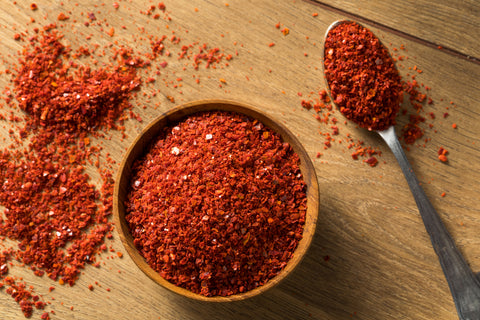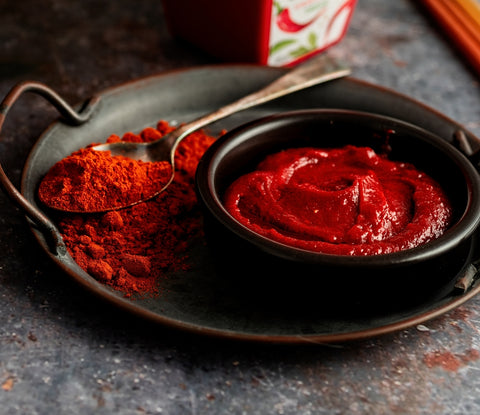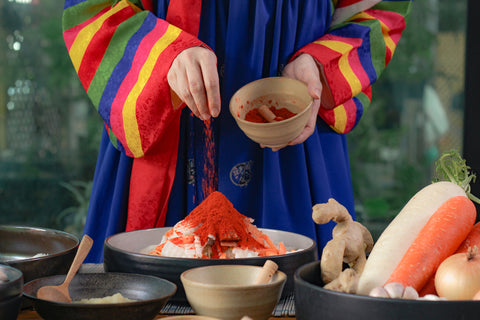The Spicy World of Gochugaru: The Essential Korean Chili Flakes
You can’t make authentic Korean meals without staple ingredients like gochugaru, the country’s signature spice. It brings heat and flavor to any dish. Let’s explore how you can use gochugaru to make spicy Korean food.
Gochugaru, Korea’s beloved red chili powder, is one of the most important traditional ingredients in Asian cuisine. It’s used to add balanced heat and spicy flavors to a variety of Korean dishes, such as kimchi, Korean tofu, tteokbokki, dakgaejang, and bulgogi. You can make gochugaru at home or buy them in stores but their taste and spiciness will depend on the type of peppers and methods used in the preparation.
The term “gochugaru” refers to the two most common versions: gochugaru flakes and gochugaru powder. Both have their own distinct features, which we’ll discuss later in this post. You will scarcely find a household or restaurant in Korea that doesn’t stock jars of gochugaru. They use it to add spice to stews, create marinades, and enhance everyday meals.
In this post, we’ll cover everything you need to know about gochugaru, including its variants, traditional preparation, culinary uses, and storage. Let’s dive in by starting with the basics.
What is Gochugaru? Understanding the Basics

Gochugaru is a Korean chili spice in the form of crushed red pepper flakes or powder. It’s typically made from seedless, sun-dried peppers. In English, gochugaru refers to Korean chili pepper, Korean hot pepper, or Korean red chili pepper. Its spiciness levels range from 1,500 to 10,000 on the Scoville Heat Scale, which is equivalent to between mild and mild-hot. That’s about the same spicy level as jalapeño, poblano, lemon drop, and tabasco. Gochugaru is different from the other peppers because of its additional flavors. This versatile spice has a distinct flavor profile that includes hot, slightly fruity, smoky, and sweet.
Gochugaru is vibrant red in color with a fine or coarse texture, depending on the variant. It smells slightly sweet, adding aroma to the dishes it graces. Gochugaru is made from sun-dried peepers in a traditional production process. After sun-drying the peppers, their stems and upper parts are cut. Next is the removal of the seeds and innards. Sometimes, the innards are kept to increase the spiciness of the final product. The seedless peppers are then ground or milled to create gochugaru.
Gochugaru flakes are one of the most popular variants in the world. Products like Assi Gochugaru Flakes are very popular among people who prefer store-bought seasonings. However, gochugaru powder is just as popular in Korean households.
Gochugaru Flakes vs. Powder: Exploring Textures

The two main types of gochugaru are gochugaru flakes and gochugaru powder. Both of them are equally popular. However, they have different appearances, textures, and culinary uses.
In terms of texture, Korean gochugaru flakes are coarse and crispy, while gochugaru powder is fine, light, and smooth. The powder variant also has a more defined color than gochugaru flakes. There isn’t much of a difference between the two in terms of tastes and flavors. In some cases, both coarse flakes and fine powder variants are used in the same dish. Separately, they offer distinct benefits in the kitchen.
Gochugaru flakes have more versatile culinary uses. They’re used to make kimchi, soups, salads, and stews. Gochugaru powder is commonly used in traditional Korean soups and side dishes in which bright colors and smoothness are required. For example, Assi Gochugaru Powder is a high-quality product that’s fine enough to keep the spice from sticking to your teeth when eating traditional dishes and sauces such as tteokbokki and gochujang, respectively.
Gochugaru vs. Gochujang: Spices and Pastes Compared

A lot of people think gochugaru and gochujang are the same but that is untrue. Although both are fundamental Korean ingredients derived from the same kind of Korean red chili peppers, they have distinct uses, flavors, and textures.
While gochugaru is a simple red chili pepper flake or powder, gochujang is a red chili paste made with additional ingredients. Gochujang typically contains soybeans, salt, and glutinous rice. It also undergoes fermentation, unlike gochugaru.
Because of its ingredients, gochujang has a savory, spicy, and sweet flavor. Hence, its flavor profile is more complex than gochugaru, which is mostly spicy and smoky.
Another common belief is that gochugaru and gochujang are substitutes for each other. This time, there is some truth to it. Both make great marinades for meat, but gochugaru would require some moisture from sesame oil or soy sauce. In urgent cases, you may directly substitute one in place of the other for glutinous rice seasoning. For a versatile gochugaru substitute in Korean dishes, we recommend Wang Gochujang Paste.
The Making of Gochugaru: A Traditional Process
Want to learn how to make Korean-style gochugaru? The traditional method is still very much in use by artisanal gochugaru producers because they believe it produces better flavors and aromas. Feel free to follow our comprehensive guide below:
-
Select the right chili peppers. You want them fiery red in color without the faintest hint of green. You should also throw out any with a hole, as this signifies the presence of caterpillars or other insects.
-
Spread the red chile peppers outside on a ground sheet and let them dry under the sun for a few hours.
-
Once they are dry enough, cut out their stems and remove the seeds and insides of the dried chiles.
-
Grind the peppers into chile flakes or powder using a stone mill.
-
Sprinkle or add the gochugaru as an ingredient in your own kimchi, sauce, stew, and other dishes.
Cooking with Gochugaru: Iconic Korean Dishes

Dozens of Korean dishes rely on gochugaru for their signature sharp taste. It infuses spicy and deep flavors into traditional meals. In native-style kimchi, gochugaru functions as an ideal condiment and seasoning. It adds mild spice and red colors to the traditional Korean banchan made of fermented cabbage or radish.
Gochugaru is also a staple Asian ingredient in Korean stews such as doenjang jjigae (soybean paste stew) and sundubu jjigae (soft tofu stew), in which it adds a little kick. You can mix gochugaru with soy sauce, sugar, and garlic to make a classic marinade for meat-based foods like dak-bokkeum-tang (braised spicy chicken).
Side dishes are not left out. A sprinkle of gochugaru on salads, eggs, and dipping sauces will enhance your everyday meal experience. You can also sprinkle some on popcorn, pancakes, pizza, and other snacks. With so many versatile uses, it’s clear to see why gochugaru is a Korean staple.
Storing Gochugaru: Tips to Preserve Freshness
Being a dried spice, gochugaru does not go bad easily and can last over a year when placed in a freezer. However, the product’s freshness and rich flavor tend to depreciate with time because of the trace amounts of moisture in it. Proper storage of gochugaru will help you preserve its aroma, flavor, and pungency.
If you’ve opened gochugaru, you can store the remaining in an airtight container for future use. Remember to place the container in a cool and dark place that doesn’t come into contact with direct sunlight or moisture. A cupboard works best.
If you have a large amount of gochugaru in the house, we recommend that you keep most of it in the freezer, but put a small amount in an airtight container and store that in a cupboard. This will allow you to get instant access to gochugaru without having to defrost it. A clear sign that gochugaru has gone bad is a change in color from red to brown.
Where to Buy Gochugaru: Finding Quality Korean Chili Flakes
To enjoy the best flavors of gochugaru, you should only use high-quality products. You’ll find them in local Korean markets and specialty stores. Another option is to purchase them from online retailers. However, always buy from a reliable online retailer like Bokksu Market. We have a proven track record of selling authentic Asian ingredients. Plus, our vast delivery network allows you to get access to a variety of high-quality gochugaru products no matter where you live.
The Enduring Appeal of Gochugaru in Korean Cuisine

Certain Korean dishes just don’t taste right without gochugaru. It elevates the taste and depth of everyday Korean cooking, especially kimchi. Many people who have enjoyed authentic traditional dishes with gochugaru refuse to use any other spice as a substitute. Hence, it has become popular in foreign countries, including the United States. Gochugaru’s versatility and the depth it adds to dishes are priceless attributes that make it one of the best condiments to come out of Asia.
Author Bio













